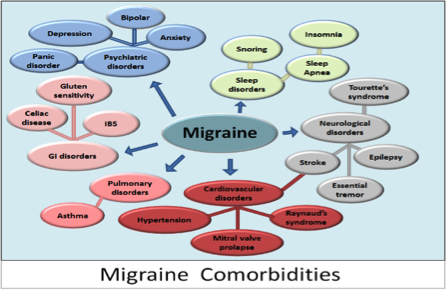Migraine Relief with EMDR

Migraine is a complex neurological disorder affecting nearly 1 in 4 households. Many migraine sufferers have multiple emotional attachments to the historical effects of their migraine experiences. Our bodies create neural networks and pathways to make more efficient responses to threats to the body for protection. One of these is the perceived anticipation of an environmental, emotional or physiological stressor. These stressors cause a part of the brain to sound the alert causing inflammation and swelling in the nerves surrounding the brain.
Getting a headache??? Just talking about headache or reading about headache may signal the brain to begin this physiological response. Physiological responses can affect other systems in the body including mental health, sleep systems, gastro-intestinal issues, cardiovascular health and neurological issues.
Getting a headache??? Just talking about headache or reading about headache may signal the brain to begin this physiological response. Physiological responses can affect other systems in the body including mental health, sleep systems, gastro-intestinal issues, cardiovascular health and neurological issues.

There are 4 phases of Migraine pain:
Prodromal - marked by a heavy or tired body sensation, including muscle tension. Often a foggy mental state interrupting concentration and ability to verbalize is diminished. This phase is where many migraine sufferers become accustomed to their triggers and prepare for an attack. The triggers for migraine can be environmental, physical or emotional.
Aura - may have any number of symptoms including dizziness, sensitivity to light or sound, touch or smell, as well as numbness tingling, pins and needles and weakness. Migraine is often accompanied by nausea and vomiting. A quarter of migraine clients experience aura as visual disturbance. This may be experienced as a blind spot in the vision, a rainbow or colors in the visual field. Aura also has auditory distortion and may cause confusion. Aura can occur without headache pain too, called a no pain migraine.
Attack - migraine headache can last between four and 72 hours if untreated. Migraine can be experienced as pain on one side or both sides of your head, which may throb or pulse. Sensitivity to light, sound, and sometimes smells and touch. Often nausea and vomiting accompany migraine. Reducing these symptoms is the aim of most migraine medications. Blurred vision, balance and fainting can also occur.
Post-drome - occurs after a migraine attack. Often feeling drained and wiped out. Confusion, fluctuating mood, dizziness and feeling weak may continue for 24 hours after attack.
LOSSES
Migraine causes loss, lost time with friends and family, lost comfort in traveling and activities, lost independence. Quality of life is reduced for migraine sufferers. Time spent attending to symptoms, recovering from attack, going to doctors, picking up prescriptions, and anticipating future attacks, none of this time can be recovered.
Relief Yes, RELIEF!
EMDR Headache protocol provides two phases of treatment. The Phase I treatment provides immediate relief of acute migraine in attack within 45minutes to an hour. Phase II treatment addresses the triggers from prodromal and post-drome migraine phases. EMDR address the neurological network of headache.
https://migraineresearchfoundation.org/about-migraine/migraine-facts
http://www.mayoclinic.org/diseases-conditions/migraine-headache
Prodromal - marked by a heavy or tired body sensation, including muscle tension. Often a foggy mental state interrupting concentration and ability to verbalize is diminished. This phase is where many migraine sufferers become accustomed to their triggers and prepare for an attack. The triggers for migraine can be environmental, physical or emotional.
Aura - may have any number of symptoms including dizziness, sensitivity to light or sound, touch or smell, as well as numbness tingling, pins and needles and weakness. Migraine is often accompanied by nausea and vomiting. A quarter of migraine clients experience aura as visual disturbance. This may be experienced as a blind spot in the vision, a rainbow or colors in the visual field. Aura also has auditory distortion and may cause confusion. Aura can occur without headache pain too, called a no pain migraine.
Attack - migraine headache can last between four and 72 hours if untreated. Migraine can be experienced as pain on one side or both sides of your head, which may throb or pulse. Sensitivity to light, sound, and sometimes smells and touch. Often nausea and vomiting accompany migraine. Reducing these symptoms is the aim of most migraine medications. Blurred vision, balance and fainting can also occur.
Post-drome - occurs after a migraine attack. Often feeling drained and wiped out. Confusion, fluctuating mood, dizziness and feeling weak may continue for 24 hours after attack.
LOSSES
Migraine causes loss, lost time with friends and family, lost comfort in traveling and activities, lost independence. Quality of life is reduced for migraine sufferers. Time spent attending to symptoms, recovering from attack, going to doctors, picking up prescriptions, and anticipating future attacks, none of this time can be recovered.
Relief Yes, RELIEF!
EMDR Headache protocol provides two phases of treatment. The Phase I treatment provides immediate relief of acute migraine in attack within 45minutes to an hour. Phase II treatment addresses the triggers from prodromal and post-drome migraine phases. EMDR address the neurological network of headache.
https://migraineresearchfoundation.org/about-migraine/migraine-facts
http://www.mayoclinic.org/diseases-conditions/migraine-headache
Headaches & Migraines
